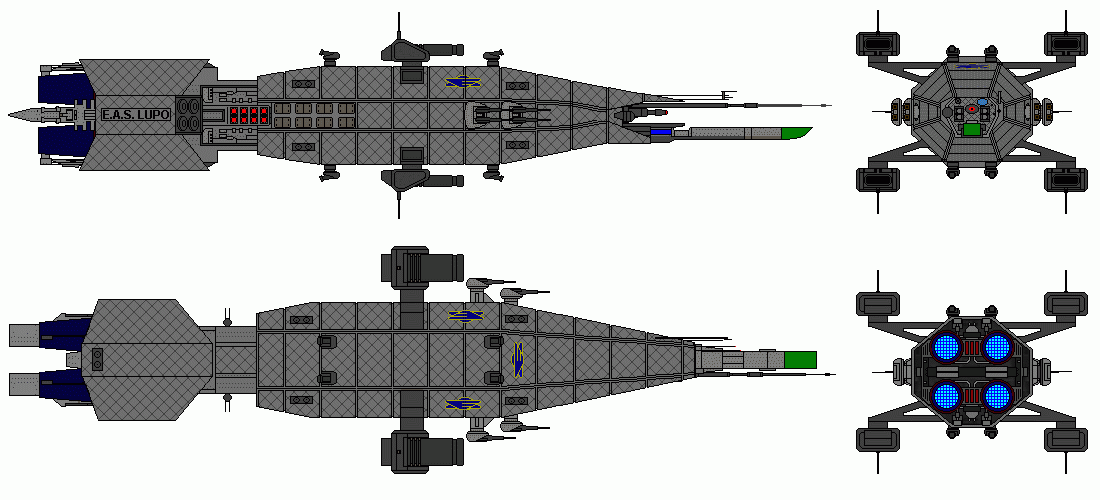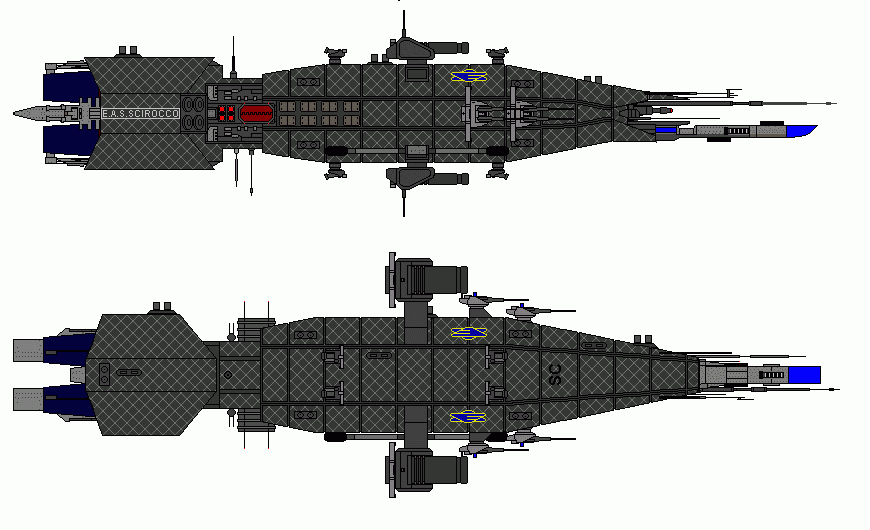
LUPO CLASS FRIGATE
A proposed successor of the Hyperion,
the Lupo Class Frigate found his place in the fleet not with the
original light cruiser role, but as one of the most effective
escort units at the day.
The design is based on a Warlock style hull, with a good
protection obtained by the use of new materials, a multi-layer
armor design and a particular care placed in the hull shaping and
internal compartimentation, enabling this design to take an hard
punishment and to survive it.
The ship design was aimed to allow a
fast and easy production and maintenance, decent offensive and
defensive firepower and good acceleration and maneuverability.
The engine plant is an improved Omega type, slightly less
powerful but lighter than the original one, and capable to
accelerate the lighter (less than half the mass of a Nova) Lupo
at a rate more than double than that of an Omega. It lacks the
artificial gravity system originally included in the design, not
installed in the production ships due to economical reasons, but
the A.G. provision and fittings are retained or built-in to allow
an easy upgrade, if and when needed.
The weapon system has is centerpiece in a pulsed spinal
Laser, that gives the bulk of
the long-range firepower of this Medium unit, and an impressive
battery of four heavy railgun turrets. Amidships are installed
four "flat barrel" HP-01 heavy plasma mortars, a new weapon design that
is becoming a good alternative to the standard Heavy pulse
cannon: even with the usual range limitation typical of the
plasma based weapons, it packs a far larger energy in a single
bolt, giving a very good short range kill capability, that, with
the combination of the railgun emplacements, makes either a
larger ship think twice before engage this fast, nimble ship. The
system is completed with eight standard Omega WRK 1005 Phalanx
anti-fighter emplacements, MK 2 interceptors, 16 missiles with
four launching tubes, and 16 starfuries. It's said that a Lupo
class frigate can be a very dangerous adversary for any ship of
his displacement, and can't be ignored even by far larger ships,
and is judicated a someway better balanced design than a Vorchan
class attack cruiser, due to the capability to carry a good
fighter complement and the all around fire arcs. The concept that
drove the weapon system design is original and effective: all the
firepower can be concentrated in the frontal arc, allowing an
extremely powerful direct attack: the spinal laser, the most
ranged weapon carried, makes the ship to maneuvre to hit the
target, but this is is not a problem in the long range fighting;
the shorter range weapons, railguns and plasma mortars, have far
larger firearcs, and the plasma mortars have an overall spherical
covering, and given the extreme power of the shot, can quickly
inflict very heavy damage to a ship incoming with every
trajectory. The same overall covering is provided by the
antifighter/interceptor systems.
The first important episode that involved this class of ships
happened in the spring of 2268. A force of four Lupo frigates was
tasked to escort a convoy of LONAW and E.A. freighters carrying a
load of quantium-40 ore sold by a Vree corporation, and directed
to the Proxima III shipyards. En route to Proxima III the convoy
was tracked and ambushed by a Drakh cruiser, and engaged by the
cruiser and his six raider flight. The battle that followed begun
with the thunderbolts of the escort struggling to take care of
the raiders, and the cruiser quickly approaching the freighters,
until one of the four frigates was able to fire a spinal laser
pulse at the far larger ship, piercing the hull and badly
damaging the engine plant. The reaction of the cruiser crippled
the shooter, but the other three frigates, using a pack attack
tactic, were able to close in to the cruiser and overwhelm the
enemy ship with a rain of railgun penetrators and plasma mortar
bolts. The outcome of the match was the destruction of the
cruiser and of two raiders, with the other raiders quickly
withdrawing from the battlefield, and five thunderbolts
destroyed: two of the four frigates were damaged, one lightly and
one more heavily, with dead and wounded aboard, the weapon system
inoperative and one of the main engines literally sliced in two
halves. The convoy was unharmed, and both the damaged units were
able to come back and were repaired and enlisted again in
service. A more than decent debout for this new escort.
During the Drakh War the potent antifighter defence
of the Lupo was a bitter surprise for the swarms of Drakh
raiders that were used in the late 2260's to attack the civilian
and freighter traffic: in the 2269 the Lupos were yet present and
used as escorts in consistent numbers, and in that same year
the Drakh raiding swarms, until then an extremely dangerous menace
to the commercial traffic in the EA territory and in the whole ISA
(actually vital due to the quarantine of the Earth), suffered enormous
casualties: the typical swarms of 20-30 raiders found themselves
ill-suited to overcome the 64 Starfuries of a typical Lupo escort
squadron (4 units), and some attempts to apply a new tactic,
so to neutralize and keep busy the escorts with an half of the forces,
and to attack the target freighters with the other half,
had disastrous outcomes: the whole fighter force of the
frigate squadron could be detached to defend the freighters,
and usually was capable to erase the enemy raiders in a few minutes,
while the other raiders used to attack the frigates were
even more short lived: the E-Web, the thick armour and the
sturdy construction allowed to the Lupos to survive with contained
or negligible damages the few strafing runs of the Drakh
raiders, while the fire of the defensive armament had devastating
effect on the Drakh formations: of a squadron of 8-10 gunships,
usually not more than three or four survived up to the firing range,
and almost none of them could live long enough to attempt a second passage.
In the 2270, after suffering bloody losses even due to the the large
diffusion of the IOWT highly accurate optical trackers,
that furtherly improved the lethality of the antifighter defence
of the Lupos, the Drakhs were forced to abandone their interdiction
activity against our lines of communications, and the Drakh fighter
force never recovered from the bleeding of trained and experienced
pilots suffered in the "interdiction war" of the 2269.
While the "turn of tide" of the Drakh War is usually identified
with the cure of the Plague in the same (2269) year and in the Sudden Nemesis
Counerattack of the 2270, in fact the Drakh miltary
might begun its decline with the "Great Butterfly Hunt" of the 2269.
Must be even noticed that
about one thirdth of the Earth Force "Fighter Aces" of the Drakh war
belonged to the Starfury wings embarked on the Lupos, while the effectiveness
of these ships allowed to free from the escort duties
a large number of Destroyers, that were much more effectively
employed in their power projection and offensive main roles.
The overall contribution of the Lupo Frigates to the Drakh War
Victory, both in direct and indirect terms, is much higher
than usually believed.
All in all, and taken into account that the Lupos are frigates,
and not destroyers, cruisers or dreadnoughts, some military technical
analysts, and even highly qualified alien observers, consider
this ship the best conceptual design ever of the Earthforce Technology.
Actually, the Lupo class frigates are the backbone of the EFNI Naval Service, presents in 42 units (2271, 16 more in program), and operate in the same roles of the Hyperion-N cruisers: information gathering, armed reconnaissance, quick strike, deep incursion and support to Special Forces operations. The modifications are a more advanced sensor suite ( I.L.S.S."Argo 2", EGAD Mk.12, and I.O.W.T. optical trackers for the weapons), an enhanced Electronic Intelligence and Electronic Warfare system, and an improved communication suite. A large landing bay, able to operate up to 6 space assault shuttles or up to 5 atmospheric assault shuttle has been added in the rear section, just beyond the interceptor launching bays. These units are an ideal replacement of the old cruisers, and, while retaining, even if improved, the overall special features of the EFNI customized Hyperion-N's, like an enhanced sensor, communication and ELINT suite, and improved facilities for special operations spacecrafts, have overall combat performances, firepower and thoughness substantially superiors to the units that are replacing.
TECHNICAL SPECIFICATIONS
Class: Lupo
Type: Frigate
Length: 1,332.6 meters
Mass: 18.5 million metric tons
Acceleration: 6.21 G
Crew: 126
Troop: None (standard) or up to 240 (Lupo-N**)
Fighters: 16 Mitchell-Hyundane SA 26-A Thunderbolt Starfury.
Other**: 6* Lockheed-Coronado
C27N space assault shuttle, or 5*Hades-N atmospheric assault
shuttles.
**(Only for the Lupo-N used by the EFNI Naval
service)
POWER/PROPULSION:
4*Westinghouse "I-Vulcan" Fusion Reactors.
4*General Electric I-85GE12 plasma engines.
2*Lockheed-Mitchell M47E2 Jump engines.
WEAPONS:
1*A.M.S. QSL - 3S
Q-spoiling Spinal Laser
4*Westinghouse/O.T.O.Melara HP-01A
Heavy Plasma Mortar turrets.
4*O.T.O.Melara 127/748 or 127/762 "Super Rapido" Twin Heavy railgun turrets.
8*Walther-Raytheon WRK
1005 Light Particle Beam/Pulse
Cannon Turrets.
16*Sandia"Shillelagh" Missiles. (Four launching tubes with automatic
reload system)
DEFENSE:
6.5 to 13.5 meter armored hull CARBONAT-VI or CARBONAT-VIII (Multi-layer composite armour), anti-neutron
ablative armour.
8*Interceptor Mk. II Defense Grid Energy Projectors
E.A.S. LUPO - LUPO CLASS FRIGATE

E.A.S. SCIROCCO, BATCH 6 LUPO CLASS FRIGATE, ( LUPO-N ) ENLISTED IN THE E.F.N.I.
